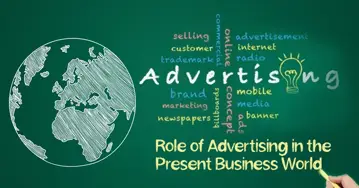What is Advertising? The Evolution of Advertising
Advertising is a powerful channel through which goods, services, and ideas reach their target markets. It has impacted the world of marketing for centuries. Understanding the answer to the fundamental question, "What is advertising?" is crucial as we traverse the complexities of the modern consumer market.
Join Aniday to delve deep into the world of advertising, explore its significance, encompassing traditional and digital realms, and discover compelling examples showcasing its transformative potential.

What Is Advertising?
Advertising serves as a promotional endeavor geared towards enticing a specific target audience to purchase a product or service. It boasts a legacy that predates contemporary marketing methods like email marketing and Search Engine Marketing.
Advertising, among the oldest marketing practices, endeavors to shape the actions of its intended audience, prompting them to make a purchase, engage in a sale, or undertake a specific action. Using carefully produced messages, advertising may be separated into two main categories: specialized for a specific target group or generic for a broad audience.
The advertising that appears in print, on television, and on the radio has been around for more than a century, making them among the more resilient kinds of advertising. Businesses may immediately reach their target audience through channels like flyers, newspapers, and the mail thanks to print advertising, which is incredibly advantageous for them.

As a result of the growing usage of the internet, advertising has been split into two distinct categories: traditional advertising and digital advertising. Digital advertising is only viewed online and uses strategies such as pay-per-click (PPC), display advertising, and social media advertising. Due to its low cost and simplicity of tracking, this sort of advertising has gained appeal and is frequently used in contemporary marketing initiatives.
Why Is Advertising Important in Marketing?
In its purest form, advertising is a form of communication. It is a technique used by businesses, associations, and people to communicate with a specific audience. In a larger sense, marketing includes advertising as a key component. Marketing, which includes a variety of actions to promote goods, services, or concepts, mainly relies on advertising to accomplish its objectives.
The Role of Advertising in Marketing

1. Increasing Awareness
One of the main purposes of advertising is to increase people's knowledge of a certain good, service, or company. Consider it the beginning of the customer's trip. Potential buyers are unlikely to even think about a product or service without awareness.
2. Information and Education
Advertising is a great medium for educating and informing customers. It offers facts on the attributes, advantages, costs, accessibility, and other factors. This helps potential customers make informed decisions.
3. Persuasion
Beyond providing information, advertising aims to persuade consumers to choose a particular product or service. This persuasive aspect is crucial in a competitive market where customers have numerous choices.
4. Building Brand Image
Successful advertising contributes significantly to shaping and enhancing a brand's image and reputation. It's about creating a personality for the brand and fostering trust among consumers.
5. Driving Sales
For the majority of firms, sales and revenue represent the bottom line. In order to draw people and persuade them to buy, advertising is essential.
6. Getting People to Act
In some cases, advertising requests that consumers take an action, such as signing up for a newsletter, visiting a website, taking part in a campaign, or even making a direct purchase.
Types of Advertising
Advertising comes in various forms, and it has evolved significantly over the years. Let's explore two primary categories: Traditional Advertising and Digital Advertising.
1. Traditional Advertising
Traditional advertising encompasses the conventional methods of reaching an audience through offline media. While it might seem old-fashioned in today's digital age, it still holds relevance and can be particularly effective for specific target demographics. Common forms of traditional advertising include:
-
Print Advertising: This refers to the placement of adverts in printed products like brochures, newspapers, and magazines. Print advertising offers the opportunity for in-depth information and visual appeal.
-
Television Commercials: Commercials on television are a traditional type of advertising. They are interesting and memorable because they frequently contain audio-visual content. The influence that television commercials can have is best demonstrated by Super Bowl commercials.
-
Radio Advertising: Because radio advertisements are only audible, they must be captivating in both language and sound to draw in listeners.
-
Outdoor Advertising: This includes billboards, posters, and transit advertisements (such as those on buses or subways). They try to communicate with those who are moving.
-
Direct Mail Advertising: Sending physical materials, like postcards and catalogs, to consumers' mailboxes is another traditional advertising method.
2. Digital Advertising
Due to the expansion of the internet and the popularity of digital platforms and devices, digital advertising has had an accelerated boom in recent years. Following are some prevalent types of digital advertising:
-
Online display advertisements: These are the graphic ads that show up on websites. They could appear as native ads, pop-ups, or banner ads.
-
Social media advertising: Websites like Facebook, Instagram, Twitter, and LinkedIn offer substitutes for advertising to a very specialized audience. These commercials are available in a range of formats, including images and videos.
-
Pay-Per-Click (PPC) advertising on search engines like Google is a very successful strategy to ensure that your product or service appears at the top of search results.
-
Email Marketing: Email campaigns are a type of online advertising that let you speak with a subscriber list directly.
-
Video Advertising: Video advertising has grown in popularity on websites like YouTube since it provides users with interesting material.
-
Influencer marketing: Working with influencers in your specialized market to promote your goods or services may be a very powerful digital advertising strategy.
The advantages of digital advertising over traditional advertising include being more targeted, quantifiable, and frequently more affordable. Businesses may fine-tune their advertising campaigns and precisely target a certain audience because to the abundance of data accessible.
Advertising Examples for Ecommerce Merchants
To illustrate the power of advertising, let's take a look at a couple of notable advertising examples from the world of ecommerce.
1. IKEA

IKEA, the Swedish furniture giant, is renowned for its innovative and memorable advertising campaigns. One of their standout advertising efforts was the "Bookbook" ad, which humorously introduced their 2015 catalog as a revolutionary product.
In the ad, IKEA's catalog is presented with the same level of hype and reverence as a new Apple product. The ad uses satire to emphasize the catalog's timeless utility and the physical experience of flipping through its pages. This clever approach resonated with viewers, making the ad go viral and generating significant brand buzz. By leveraging humor and creativity, IKEA effectively engaged its audience and strengthened its brand image.
2. Lego

The well-known toy business Lego has constantly produced effective advertisements. Their "Build the Future" commercial is a striking illustration. It's not only about promoting their products; a bigger message is also being delivered. The children in the advertisement talk about their imaginative and upbeat predictions for the future. With the motto "Build the future", Lego aims to inspire kids to utilize their imagination and problem-solving abilities to improve the world.
This advertisement promotes Lego as a business that encourages creativity and invention in addition to selling a product. By focusing on a deeper message, Lego connects with its target audience on an emotional level.
The effectiveness of creativity and storytelling in advertising is shown by these examples. They are not only promoting products; they are also disseminating a message and creating an indelible impression on the audience.
Conclusion
Advertising is still a crucial tool for reaching, educating, convincing, and interacting with your target audience in the ever-changing world of marketing. The art of advertising is about creating appealing storylines and pictures that connect with people, whether through conventional channels like television or the newest digital platforms.
Remember to ask yourself "How can I make my advertising memorable and impactful?" as you navigate the world of advertising rather than just "What is advertising?". The solution is found in inventiveness, originality, and a profound comprehension of the needs and goals of your audience. Aniday believe that the world of advertising is a world worth exploring and enjoying, whether you're an entrepreneur, a marketer, or simply a consumer.
Aniday's HR Services
Headhunting Service
Find and recruit quality candidates in just 1 week! Supported by 40,000 experienced headhunters in IT, Finance, Marketing… capable of recruiting in any region.
Headhunting Service ➔Employer of Record (EOR) Service
On behalf of your business, we recruit employees and handle payroll without the need to establish a company in markets such as Vietnam, Singapore, Malaysia, India, Indonesia…
Employer of Record (EOR) Service ➔